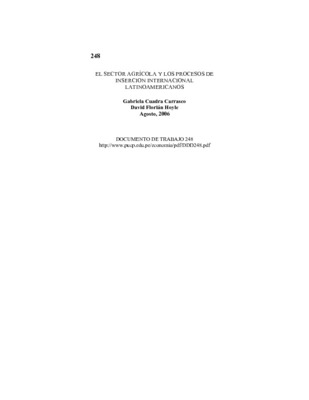| dc.contributor.author | Cuadra Carrasco, Gabriela | |
| dc.contributor.author | Florián Hoyle, David | |
| dc.date.accessioned | 2015-03-19T20:37:45Z | |
| dc.date.available | 2015-03-19T20:37:45Z | |
| dc.date.issued | 2006 | |
| dc.identifier.uri | http://repositorio.pucp.edu.pe/index/handle/123456789/46888 | |
| dc.description.abstract | El presente documento analiza los efectos de la liberalización y/o exclusión del sector agrícola en los procesos de integración en los que se encuentran inmersos los países latinoamericanos a partir de la comparación de 4 diferentes modos de liberalización. El objetivo central consiste en determinar si es o no necesario que éste sector reciba un tratamiento especial en comparación con el resto de sectores económicos, o si es más favorable la liberalización completa o la exclusión del agro en los procesos de integración. Para ello, empleamos como herramienta un modelo EGC estático, multipaís y multisectorial de corto y largo plazo el cual cuenta con una desagregación predominantemente agrícola. Entre los principales resultados encontramos que si bien los 4 tipos de liberalización generan resultados positivos en las economías latinoamericanas, para el Perú, Venezuela, Ecuador-Bolivia, Argentina y Uruguay la estrategia multilateral que excluye al sector agrícola genera mayores beneficios que la liberalización netamente arancelaria. No obstante si se compara la liberalización netamente arancelaria versus la total (que incluye eliminación de los subsidios a la exportación y franja de precios), todos los países con excepción de Perú y Venezuela registran mayores beneficios con la liberalización total. | es_ES |
| dc.description.abstract | This paper analyzes the effects of the liberalization and/or exclusion of the agricultural sector in the integration processes in which are immersed the Latin American Countries from the comparison of 4 different ways from liberalization. The central objective consists of determining if it is necessary that this sector receives a special treatment in comparison with the rest of economic sectors, or if the complete liberalization is more/less favorable than the exclusion of the agriculture in the integration processes. We used a static CGE model, multisectorial, multicountry of short and long term that has a predominantly agricultural aggregation. Between the main results we found that although the 4 types of liberalization generate positive results in the Latin American economies; for Peru, Venezuela, Ecuador-Bolivia, Argentina and Uruguay the multilateral strategy that excludes the agricultural sector generates greater benefits than the net tariff liberalization. Despite if we compare the tariff liberalization versus the total liberalization (one that includes export subsidies elimination and band of prices), all the countries with exception of Peru and Venezuela register greater benefits with the total liberalization. | en_US |
| dc.language.iso | spa | es_ES |
| dc.publisher | Pontificia Universidad Católica del Perú. Departamento de Economía | es_ES |
| dc.relation.ispartofseries | Documento de Trabajo;248 | es_ES |
| dc.rights | info:eu-repo/semantics/openAccess | es_ES |
| dc.rights.uri | http://creativecommons.org/licenses/by-nc-nd/2.5/pe/ | * |
| dc.subject | Agricultura--Perú | es_ES |
| dc.subject | Liberalización comercial--Perú | es_ES |
| dc.subject | Proteccionismo--Perú | es_ES |
| dc.title | El sector agrícola y los procesos de inserción internacional latinoamericanos | es_ES |
| dc.title.alternative | The agricultural sector and Latin American international insertion. | en_US |
| dc.type | info:eu-repo/semantics/workingPaper | |
| dc.type.other | Documento de trabajo | |
| dc.subject.ocde | http://purl.org/pe-repo/ocde/ford#5.02.00 | |
| dc.publisher.country | PE | |


